| 1 | The strongest US river snake |
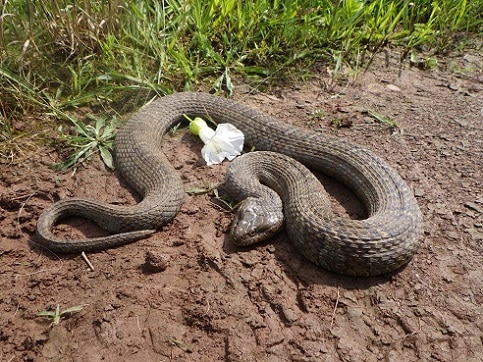
The USA is home to many water-loving snakes, including queen snakes and cottonmouths. However, the most powerful is undoubtedly the northern watersnake, a relative of the brown watersnake further south.
This species is extremely flexible, living in endless different watery environments. Northern watersnakes can live in giant reservoirs, mixed wetlands, and roadside lakes. They can live in rivers both fast-flowing and slow-flowing, from small shallow streams to raging tributaries. Northern watersnakes can even live in manmade dams and town canals. They only have one slight preference: when autumn arrives and the first chill appears in the air, they gravitate towards warmer water bodies.
Northern watersnakes have all the requisite skills for a semi-aquatic snake. They’re excellent divers, able to hold their breath underwater for 90 minutes. Their average dive lasts 80 seconds, while occasionally they reappear after just 2 seconds. Northern watersnakes rarely stray more than a few metres from water. Younglings tend to stay in shade beneath the canopies, while adults grow bolder and move to the raging centres of rivers. This is primarily a species of the northeastern US, spilling into southern Canada.
| 2 | Non-venomous but aggressive |
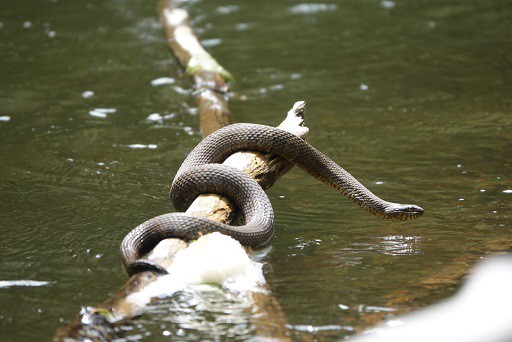
Northern watersnakes zip along at a fast speed, and regularly come into contact with human beings. At public riversides, the sight of their brown heads bobbing up and down regularly causes entire shores to empty, with people stuffing their picnic boxes full in a panic. Police officers are summoned only to find that the snake is long gone, to a newer, more sparkling stretch of river.
In reality, northern watersnakes are incapable of killing. They’re non-venomous, and tackle their prey through relentless charging instead. That said, they’re one of the angrier non-venomous snakes, particularly compared to the calm brown watersnake further south.
When picked up, northern watersnakes won’t hesitate to swing down savagely with their stronger than average jaws. They’ll hiss and thrash and do everything in their power to make you retreat, even regurgitating their last meal to make themselves seem utterly disgusting. Legend states that a northern watersnake swimming past a boat will change direction and start heading directly towards it.
| 3 | Comfortable in polluted urban areas |
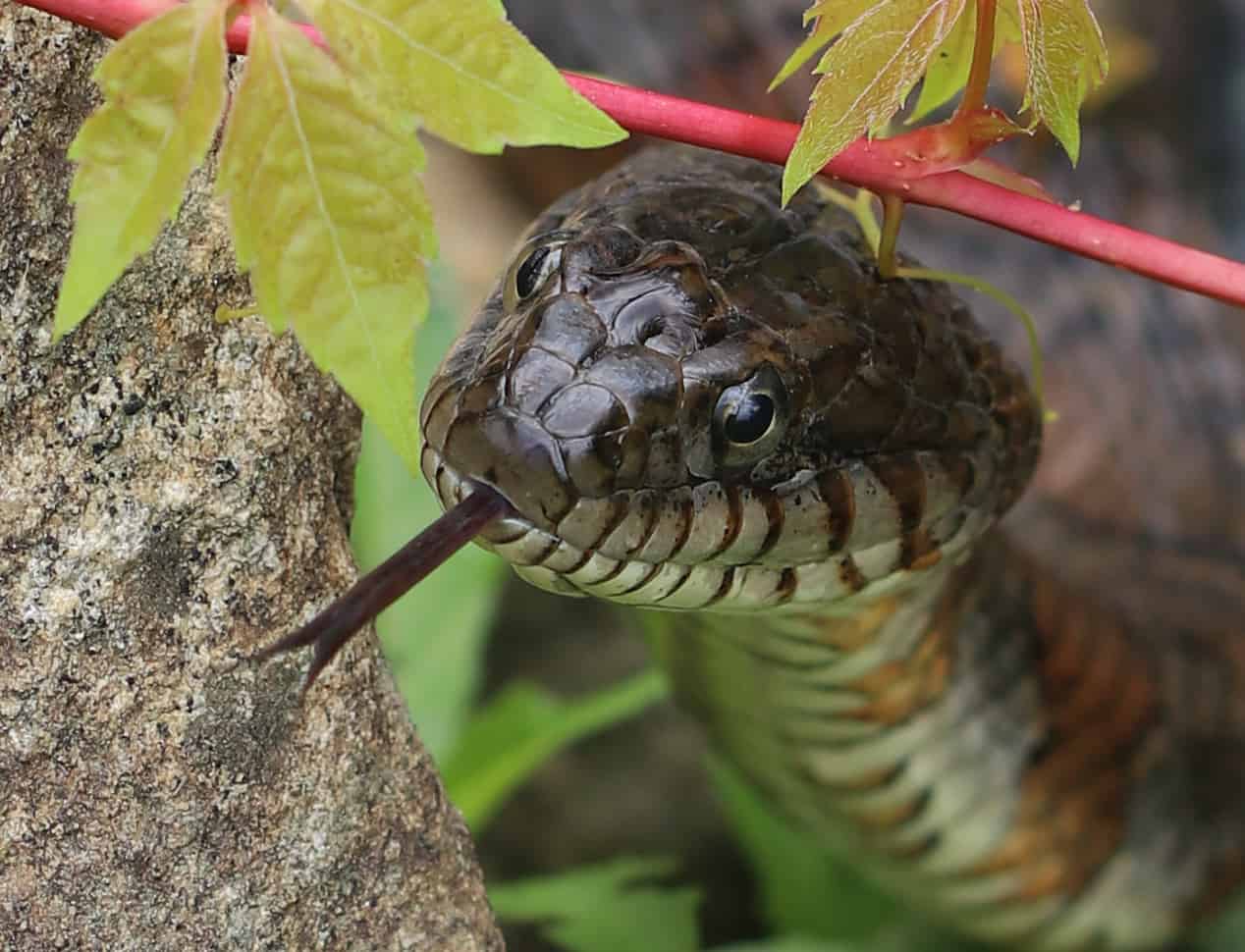
The queen snake of the northeast US has very restricted habitat requirements. They cling to wild countryside rivers with a rugged rocky bed, and are now endangered in New York state. Meanwhile, the northern watersnake is well at home in the centre of concrete towns. In fact, they may even prefer industrialised urban rivers.
A 2009 study followed 50 northern watersnakes in a 2km stretch of Pennsylvania. This included both natural conservation habitats, and urban zones ranging from municipal parks to industrial sites. When the snakes were picked up and relocated, they swam back to the urban areas significantly more than natural ones.
The snakes found comfy refuges in trees artificially tied to the banks (to combat erosion), holes in a railway track adjacent to the river, and even piles of scrap metal dumped at the side. Northern water snakes are even comfortable in smooth-sided boat canals bordered on all sides by concrete. This is a tough and hardy species. Forget swamps; you could probably find this snake under a polluted bridge with chocolate wrappers floating in it.
| 4 | Changes body shape while swimming |
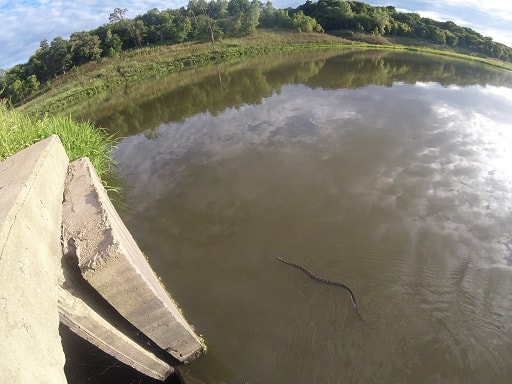
The northern watersnake is a particularly powerful swimmer. They begin by contracting their neck muscles, then thrashing their body from side to side. This swishes water out of the way like a paddle, and creates a mini wave which the northern watersnake rides to move forward. All this happens at blink and you’ll miss it speeds.
This species also has the power to change its body shape. While swimming, they compress the bones of their lower half, making them closer in shape to sea snakes. These adaptions allow Nerodia sipedon to live in the fastest flowing rivers, rivers where an eastern ribbon snake would be washed away helplessly.
One obstacle they do face is the weather. It’s proven that as temperatures fall, the northern watersnake swims at slower speeds, due to a lower metabolic rate. Despite their unceasing hunger, northern watersnakes are beneficial to fish populations in the rivers where they live. They feed on dying and diseased fish, controlling numbers and allowing healthy ones to thrive.
| 5 | Eats nearly 100% fish |
The brown watersnake eats 60% catfish, despite the painful spines that often puncture their skin. The northern watersnake takes a different path. It mostly eats fish, but with no limits; it has one of the longest lists of fish prey of any snake. 19 families and over 80 species are confirmed, all within the eastern USA. There’s trout, sunfish, suckers, and shads, with minnows making up the highest proportion.
Northern watersnakes grab and catch their prey, not bothering to constrict. They have at least 4 different hunting styles. The first is probing, searching carefully through rocks while flecking their tongue to pick up subtle scents. The second is underwater, swimming in a straight line across the riverbed, while not flecking their tongues at all.
The third strategy is ambush, waiting patiently with only their head poking out above the water surface, searching for movement. The final strategy is like number two, swimming forward directly, except on the water surface.
| 6 | A nervous, alert snake |
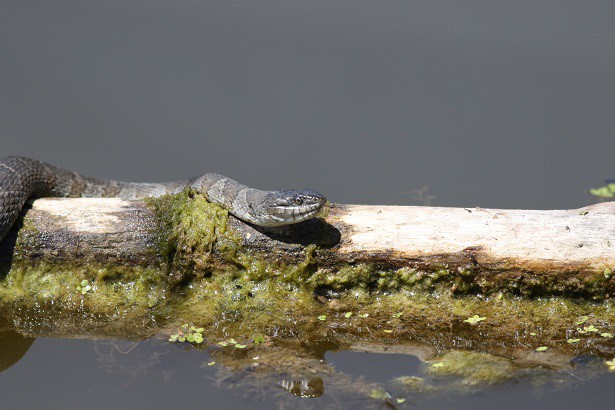
Northern watersnakes are particularly sensitive to people compared to their watery neighbours. Scientists identified snakes resting between a popular pedestrian path and water, and walked towards them carefully. The northern watersnakes reacted at distances of 2-3 metres, raising their heads up alertly. The common garter snakes (which like water but less strictly) barely reacted at 1.5 metres.
Another study compared them to common garters and eastern ribbon snakes (another member of the garter family). When spooked, Nerodia sipedon fled much further across the water than those snakes, which preferred to stay still and rely on camouflage. Northern watersnakes are more likely both to bite and flee; they’re twitchier and jumpier in every way, whereas garter snakes have calmer personalities.
Northern watersnakes can also detach their tail, by performing a hard roll as the predator grips it. The tail continues to twitch, and the snake’s bleeding stump actually barely bleeds at all.
| 7 | Lures prey with its tongue |
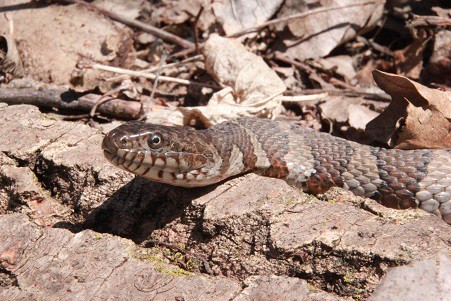
Fish rule, but northern watersnakes also eat amphibians, and get the majority of calories from them in certain lakes where they’re concentrated. Favourites include the American toad and plains leopard frog.
It’s quite common for snakes to lure prey in with a colourful tail tip, which mistake it for insects. However, northern watersnakes do the same thing with their tongues. They submerge their entire body, using their enhanced physiology to make each oxygen molecule go further, and stick only their tongue above the surface. Northern watersnakes fall victim to predators themselves, including largemouth bass, snapping turtles, racoons, and kingsnakes. In Virginia, one was found inside the stomach of a cottonmouth.
Northern watersnakes love to bask on tree branches, warming their bodies in the sun, or maybe just because they enjoy it. This species has wildly variable egg counts, as low as 4, but as high as 99. A 1940 study from Michigan and New York found an average clutch of 22.7 eggs.
| 8 | How to ID them |
Northern watersnakes reach a record length of 135cm. Females average at 70cm, while males are shorter at 60cm. They have round pupils, and their belly is far paler than their back, usually ivory white or yellow.
Because of their brown and grey shades, Nerodia sipedon is often confused with the notorious cottonmouth. They actually look closer than the brown watersnake down south, because like the cottonmouth, the dark bands join at the spine. The cottonmouth’s far bulkier head is the clearest ID giveaway, but few have to worry about this anyway.
The two could be misidentified in a few states, such as Virginia, southern Illinois, southern Indiana, Kentucky, and Tennessee. However, there’s a lengthy list where the cottonmouth doesn’t even exist, including Nebraska, Ohio, Pennsylvania, West Virginia, New York, Michigan, Wisconsin and Iowa. Northern watersnakes overlap far more extensively with the copperhead (which lives further north), but these are far simpler to distinguish. The copperhead’s orange-red colours and their hourglass-shaped markings are far more vivid.
| 9 | Ancient fossils |
Northern watersnakes have been around for several epochs, and have no intention of surrendering their river strongholds. The oldest clearly recognisable fossils date back 4.25-3.7 million years, and were unearthed in Nebraska. Another batch from Nebraska and Kansas date to 3.7-1.9 MYA, and recent fossils dating to 10,000 years ago have been discovered in several states.
The only limit of northern watersnakes is that they avoid saltwater, or even brackish water (between fresh and salty). This species is rated as “least concern” and is one of the USA’s most common snakes, even straying into Ontario. They’ve also expanded their territory by becoming an invasive species in San Joaquin, California.
Their furthest natural point west is eastern Colorado, but whether through a mass pet breakout or hiding in transport trucks, they’ve made it to California’s lush valleys. The worry is that they might steal frog prey from native snakes, such as the endangered giant garter snake. They’ve been confirmed to eat native Pacific chorus frogs, which the giant garter relies on.
| 10 | The Lake Erie subspecies |
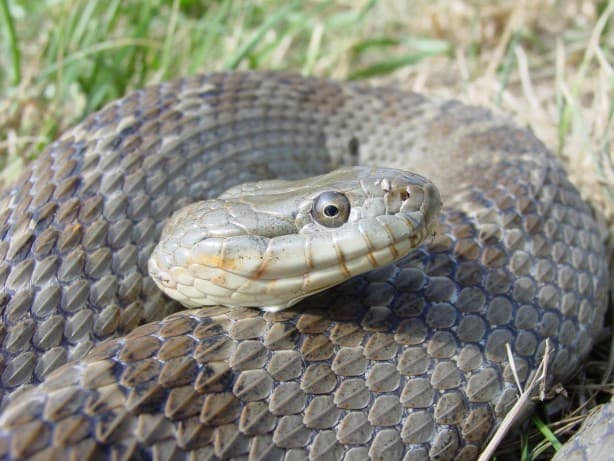
The northern watersnake has 4 subspecies, the most common being Nerodia sipedon sipsedon. The rarest is the Lake Erie watersnake (N. sipedon insularum), which had plummeted to just 1500 individuals by 1999. It resides on the western islands of Lake Eerie, the fourth largest of the Great Lakes, bordered by Michigan to the west.
The Lake Erie watersnake has less prominent bands, giving them a uniformly grey or near black appearance, contrasting against a pale white belly. This probably evolved to help them blend in with damp shoreline rocks.
The decline started when tourists and islanders arrived in the 1950s, killing the snakes out of fear. The area had been dubbed the “serpent islands” since the days of early European settlers. In the 1990s, the federal government protected 11 square miles of land. But whether this actually worked is anyone’s guess. These days, the Lake Erie watersnake has recovered to 12,000 individuals, and the main reason is an invasive fish species called the round goby. This has wiped out many native amphibians, but the watersnakes adore the taste, and can’t get enough of them. Thanks to this random twist of fate, the Lake Eerie watersnake is now thriving again.
